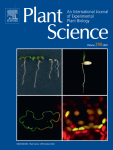Ver ítem
- xmlui.general.dspace_homeCentros e Institutos de InvestigaciónCIAP. Centro de Investigaciones AgropecuariasInstituto de Fisiología y Recursos Genéticos VegetalesArtículos científicosxmlui.ArtifactBrowser.ItemViewer.trail
- Inicio
- Centros e Institutos de Investigación
- CIAP. Centro de Investigaciones Agropecuarias
- Instituto de Fisiología y Recursos Genéticos Vegetales
- Artículos científicos
- Ver ítem
Physiological characterization of four model Lotus diploid genotypes: L. japonicus (MG20 and Gifu), L. filicaulis, and L. burttii under salt stress
Resumen
The genus Lotus comprises a heterogeneous group of annual and perennial species. Lotus japonicus (with MG20 and Gifu ecotypes) has been adopted as one of the model legumes in genetic and genomic studies. Other Lotus species, such us Lotus burttii and Lotus filicaulis, have also been used in genetic and genomic studies because of their capacity to produce fertile progenies in crosses with L. japonicus. In the present work, physiological responses to salt
[ver mas...]
The genus Lotus comprises a heterogeneous group of annual and perennial species. Lotus japonicus (with MG20 and Gifu ecotypes) has been adopted as one of the model legumes in genetic and genomic studies. Other Lotus species, such us Lotus burttii and Lotus filicaulis, have also been used in genetic and genomic studies because of their capacity to produce fertile progenies in crosses with L. japonicus. In the present work, physiological responses to salt stress in four Lotus genotypes were evaluated on the basis of growth and associated parameters, such as photosynthesis, ions, relative water content, oxidative damage and antioxidant system responses, using two NaCl levels applied by acclimation for up to 28 and 60 d. Growth responses varied with plant developmental stage in the four Lotus genotypes. L. japonicus MG20 was found to be a salt-tolerant genotype, mainly when exposed to salt stress at the young plant stage. The capacity of Lj MG20 to sustain growth under salt stress was correlated with enhancement of Superoxide dismutase and Glutathione reductase activities, as well as with increases in total and reduced glutathione content and lower Na+ accumulation in leaves. These results suggest that enhancement of antioxidant responses in Lj MG20 contributed to improve salt stress tolerance at early stages. On the other hand, after long-term high NaCl stress treatment, L. filicaulis exhibited lower biomass reduction, lower oxidative damage and Na+ accumulation in leaves than the control treatment; hence, this genotype was considered salt-tolerant. These apparently ambiguous results remark that salt tolerance, as a development-related process, was differentially expressed among the Lotus genotypes and depended on stress duration and plant phenological stage.
[Cerrar]

Autor
Fuente
Plant Science 177 (6) : 618-628 (December 2009)
Fecha
2009-09-25
Editorial
Elsevier
ISSN
0168-9452
Formato
pdf
Tipo de documento
artículo
Palabras Claves
Derechos de acceso
Restringido
 Excepto donde se diga explicitamente, este item se publica bajo la siguiente descripción: Creative Commons Attribution-NonCommercial-ShareAlike 2.5 Unported (CC BY-NC-SA 2.5)
Excepto donde se diga explicitamente, este item se publica bajo la siguiente descripción: Creative Commons Attribution-NonCommercial-ShareAlike 2.5 Unported (CC BY-NC-SA 2.5)

